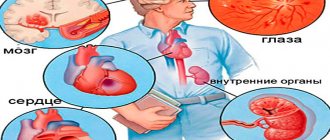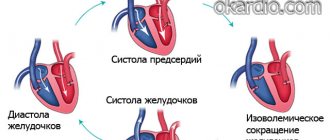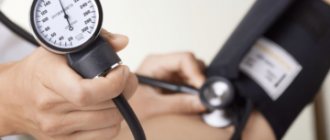The only way to know if you have high or low blood pressure is to measure your blood pressure. Understanding your results is key to controlling your blood pressure.
- Systolic blood pressure (First or top number) is the maximum pressure in the arteries when the heart contracts and pushes blood into the arteries.
- Diastolic blood pressure (Second or lower number) - shows the pressure in the arteries at the moment the heart muscle relaxes, it reflects the resistance of peripheral vessels.
What pressure is considered the most normal?
Normal blood pressure is 100-139 mm Hg. Art. If systolic pressure drops below 90 mm, hypotension occurs.
This condition is potentially not dangerous, but can create a strong feeling of discomfort. The most unpleasant thing about hypotension is a significant decrease in concentration. A person faced with such an illness will find it difficult to even read. If systolic pressure exceeds 140 mm, hypertension is recorded.
Why does the lower pressure change?
An increase in lower pressure may be associated with:
- Narrowing of the lumen in the renal arteries, their increased tone;
- Kidney diseases;
- Significant excess weight;
- Myocardial dysfunction;
- Diabetes mellitus;
- Changes in the concentration of hormones in the blood.
When diastolic pressure deviates from the norm, a person feels a loss of strength, chills in the lower extremities, and drowsiness. A nagging headache appears, sweating increases, concentration decreases and memory deteriorates. Possible discomfort in the heart area, arrhythmia. This is why it is important to measure your blood pressure regularly so that if there are any abnormalities, you can immediately consult a doctor.
What are the symptoms of hypertension
High blood pressure can cause great harm to the human body. Often it indicates the presence of pathologies. This phenomenon occurs due to high vascular resistance. But this is only one of the possible options. Only an experienced doctor can give accurate information. It is important to take into account that the state of blood pressure can be influenced by overwork, the use of special medications, and the inclusion in the diet of food containing substances that affect blood pressure.
In medicine, there are several conditions of blood pressure:
- normal;
- high;
- hypertension 1 degree;
- hypertension 2 degrees;
- hypertension 3 degrees.
Note that grade 3 hypertension is registered when the level reaches 180/110 mmHg. Art. A large number of different studies have been conducted regarding arterial hypertension, but they have not been able to identify the exact causes of the development of hypertension.
What does systolic blood pressure indicate?
Any deviations of indicators from the norm indicate malfunctions in the functioning of one or another body system. Both values or only one of them can increase or decrease. For example, an increase in systolic pressure occurs when:
- Overactive thyroid gland – thyrotoxicosis, when the thyroid gland secretes too many hormones;
- Severe anemia, when the type of blood circulation changes;
- Slowing of the pulse - bradycardia, ineffective operation of the aortic valve, when the upper pressure increases due to increased blood release;
- A decrease in the elasticity of the aorta, an increase in the density of its walls - most often the cause is atherosclerosis of a large vessel in old age.
An increase in only the upper pressure without changes in the lower is called systolic arterial hypertension. But such a deviation does not always indicate a disease. So, with significant sports loads, an increase in upper pressure is also observed, and this is not considered a deviation from the norm.
What reasons can cause high blood pressure
Medicine has established the most common causes that can cause high blood pressure in the human body. These include influencing factors such as drugs, diseases of the urinary system, endocrine diseases, aortic diseases, complications arising during pregnancy, problems with the nervous system.
Antidepressants and glucocorticosteroids (for example, prednisolone) can cause high blood pressure. Contraceptives can also have a negative impact. Risk factors that can lead to the development of hypertension include the following:
- Hereditary factors.
- Prematurity.
- A child's low weight may indicate a potential predisposition to high blood pressure.
- Large overweight.
- High salt content in food. The norm for table salt consumption is considered to be 5 grams per day.
- Drinking alcohol, smoking. Bad habits can worsen the condition of blood vessels and affect the circulatory system in the most detrimental way.
- Insufficient physical activity.
- Poor environment, daily stress, increased noise levels.
Of all these factors, it is necessary to focus a lot of attention on excess weight, bad habits, and severe stress. In most cases, these reasons increase the risk of hypertension.
Renal or cardiac?
There is an opinion that the upper pressure indicator is cardiac, and the lower one is renal. “The top number is systolic blood pressure, it shows the pressure in the arteries at the moment when the heart contracts and pushes blood into the arteries, it depends on the force of the heart contraction, the resistance that the walls of the blood vessels exert, and the number of heartbeats per unit time. Therefore, in general, we can say that this indicator reflects the work of the heart, although, of course, other factors also take part in this process,” says Maria Benevskaya.
It is also not worth ruling out that the lower indicator reflects kidney function. “The bottom number is diastolic blood pressure, which shows the pressure in the arteries when the heart muscle relaxes. This is the minimum pressure in the arteries and reflects the resistance of peripheral vessels. Since vascular tone is regulated by chemicals and the autonomic nervous system, lower blood pressure indicates the extent to which neurohumoral regulation is carried out correctly. In turn, neurohumoral reactions occur mainly in the kidneys, which is why there is an opinion that the “lower” pressure is renal. But it would be more correct to note that lower pressure reflects the work of blood vessels and kidneys,” says the cardiologist.
Lack of oxygen, loss of strength. How pressure surges affect the brain Read more
What pressure is considered critical?
We noted that the highest pressure in the world was 310/220 mm Hg. Art. However, doctors say that 260/160 mm Hg is considered critical indicators. Art. Thus, the record blood pressure can be considered a phenomenon, because even at critical values the human body can die.
The occurrence of hypertension can lead to hypoxia, the greatest harm of which is the negative impact on the brain, which is actually deprived of oxygen. The problem with the brain lies in its seemingly unusually developed blood supply system. The vascular ring can work normally only at normal pressure values. Otherwise, tone regulation is disrupted, permeability increases, and then hypoxia may develop.
HOW TO MONITOR PRESSURE AT HOME?
There is an official diagnostic method - “Home blood pressure monitoring”, when the results of measuring blood pressure in the morning and evening at home are entered into a table. The doctor looks at this table and adjusts the treatment. Such monitoring is especially important for “white coat” hypertension, for latent “anterior hypertension”, when the pressure is high at home but normal at a doctor’s appointment, when prescribing new antihypertensive therapy, or nocturnal hypertension.
What is the prevention of high blood pressure?
People who experience high blood pressure need to remember the need for regular checks. Often a person does not feel symptoms and does not suspect what danger blood pressure hides. Even with long-term hypertension, people ignore the condition, attributing everything to fatigue or overwork. It is important to understand that pressure increases when blood vessels narrow, when the heart has to work at “high speed.”
Foods containing large amounts of saturated fatty acids can lead to hypertension. The highest content of these substances is found in butter, cheeses, and sour cream. It is recommended to avoid products containing large amounts of palm oil. Cake, chocolate, cookies, fatty sausage, chips are all sources of saturated fatty acids. Of course, it is important to take into account physical activity; you need to eat exactly as much as the body needs to ensure normal functioning. Moreover, you need to take into account the composition of the products. Many manufacturers even indicate the percentage of EFA content per 100 grams.
The amount of salt consumed also needs to be reduced. Scientists have long noticed the effect it can have on the human body when consumed excessively. The biggest problem is that most foods sold on supermarket shelves contain quite a bit of salt. By using this additive in our diet, we expose our body to even more danger. For those who love salty foods, the best option to get rid of excess is physical activity. Salt can reduce the elasticity of blood vessels and negatively affect the kidneys and liver.
St. Petersburg State Budgetary Healthcare Institution "Polyclinic No. 98"
Blood pressure level is one of the clearest indicators of health status. True, most often the need to monitor blood pressure is remembered in diseases of the cardiovascular system. In fact, everyone should know everything about their blood pressure, because it changes for various reasons.
What is blood pressure?
Blood pressure (BP) is the pressure that blood exerts on the walls of the arteries. It is uneven and fluctuates depending on the phase of the heart. During systole, when the heart contracts and releases another portion of blood into the vessels, the pressure increases. And in diastole, when the heart relaxes and fills with blood, the pressure in the arteries decreases. The blood pressure on the walls of the arteries in systole is called “upper” or systolic, and in diastole – “lower” or diastolic. It is customary to write the blood pressure value using a fraction: the first is the upper, the second is the lower.
Blood pressure is one of the most important indicators of the cardiovascular system. In most healthy people it is relatively constant. But under the influence of stress, physical activity, overwork, drinking large amounts of liquid and under the influence of other factors, its value may change. Typically, such changes are either not too frequent or not too strong, and do not exceed 20 mm during the day. rt. Art. – for systolic, 10 mm. rt. Art. – for diastolic. But, a repeated or persistent decrease or increase in pressure beyond the normal range may be an alarming signal of illness and requires immediate consultation with a doctor.
Blood pressure standards according to WHO classification
| Blood pressure (category) | Upper blood pressure (mm Hg) | Lower blood pressure (mm Hg) |
| Hypotension (low) | below 100 | below 60 |
| Optimal pressure | 100–119 | 60–79 |
| Normal pressure | 120–129 | 80–84 |
| High normal pressure | 130–139 | 85–89 |
| Moderate hypertension (increased) | 140–159 | 90–99 |
| Moderate hypertension | 160–179 | 100–109 |
| Severe hypertension | more than 180 | more than 110 |
The ideal “cosmonaut pressure” is 120/80 mm. rt. Art. However, many doctors agree that everyone has their own ideal, and therefore often ask about the patient’s “working” pressure. Working blood pressure is the usual constant blood pressure interval that provides a person with good health. Since this interval is individual, for someone 115/80 with a working 130/90 may be lower, although it falls within the normal range. And, conversely, with a working level of 110/80, 130/90 may become elevated. Knowing the working pressure helps the doctor to timely identify pathology, make a more accurate diagnosis and choose the right treatment.
However, it is worth remembering that pressure beyond the lower and upper limits of the norm is not working for a healthy person. And feeling normal in this case is only an additional reason to seek advice from a specialist.
Who needs to monitor blood pressure levels and how?
One of the most common disorders of blood pressure regulation is hypertension. Often behind it lies hypertension, leading to myocardial infarction, stroke and other serious complications. Unfortunately, arterial hypertension is often asymptomatic, so everyone needs to monitor their blood pressure. People who are prone to increasing it, who are exposed to risk factors for developing hypertension and experiencing its symptoms should be especially careful and measure blood pressure from time to time. For the rest, annual monitoring during the medical examination period is quite sufficient. But for those who have been diagnosed with arterial hypertension, it would be good to make friends with a tonometer and check the pressure level at least twice a day - in the morning and in the evening.
It is imperative to measure blood pressure if you experience weakness, dizziness, headache, darkening, “veil” in the eyes, tinnitus, difficulty breathing, pain and heaviness in the heart area or behind the sternum, or when other symptoms appear that usually accompany an increase or decrease in pressure.
It is also worth monitoring blood pressure during exercise, especially when selecting a load.
How to measure blood pressure correctly?
If the blood pressure measurement is planned, then one hour before the measurement you should not drink alcohol, drinks containing caffeine (tea, cola, coffee) or smoke, and five minutes before the measurement, ensure yourself a state of rest.
At the first visit to the doctor, the pressure is measured on both arms alternately. If the results differ by more than 10 mm. rt. Art., then the subsequent measurement is carried out on the arm with a high blood pressure value. However, normally the readings are approximately the same. The difference between them exceeds 10 mm. rt. Art., indicates an increased risk of diseases of the cardiovascular system and death from them or an existing pathology.
Blood pressure is usually measured while sitting or lying down. The hand on which the measurement is taken should be freed from clothing and compressive objects, relaxed and motionless. To avoid unwanted tension, it can be placed on an object that provides a support point, such as a table or the edge of a bed. It is best to position the limb so that the elbow is at the level of the heart. The arm should not have arteriovenous fistulas for dialysis, traces of a section of the brachial artery, or lymphedema.
The cuff is placed on the shoulder 2 cm above the elbow. It is important that it fits your hand tightly, but does not squeeze it.
Ideally, blood pressure is measured twice with an interval of 2 minutes. If the result differs by more than 5 mm. rt. Art. – after 2 minutes, take the third measurement and calculate the average value.
The method of measuring pressure depends on the device used and is indicated in the operating instructions.
How to choose a pressure measuring device?
The device for measuring pressure is called a tonometer. There are two types of tonometers - mechanical and electronic (automatic and semi-automatic).
A mechanical tonometer is inexpensive, reliable, lasts a long time, guarantees high measurement accuracy, is easy to use, but requires certain skills and is more difficult to use without assistance.
The electronic tonometer is convenient and simple; you can easily use it yourself. In addition to devices that measure pressure on the shoulder, there are also those that measure it on the wrist. This tonometer can be carried with you, which is sometimes important for some hypertensive patients. And devices with large dials come in very handy for older people. Many of the electronic tonometers show the pulse, remember the data of the latest measurements and are equipped with some other functions, the quantity and quality of which largely depends on the price of the device. But automatic and semi-automatic devices are more expensive than mechanical ones, less accurate and may last slightly less. In addition, in some diseases, blood pressure is very difficult to measure with an electronic tonometer, for example, with atrial fibrillation.
When purchasing a tonometer, you must pay attention to the presence of instructions in Russian, a passport of the device, a warranty card and the absence of visible defects. And when purchasing an electronic device, it also depends on the country of origin. Japanese and German devices are traditionally considered the best.
If the choice falls on a mechanical tonometer, it is worth remembering that it requires a phonendoscope. It is often not included in the package.
It is best to buy pressure measuring devices at a pharmacy or specialty store. If the device is purchased secondhand, the accuracy of the measurement and its service life cannot be guaranteed.
The average width of the cuff should be 13–17 cm, for children - a little less, for overweight people - a little more.
Before use, the tonometer should be checked and, if necessary, adjusted. It is easier and more correct to do this with the help of a doctor.
How to measure blood pressure with a mechanical tonometer?
Not everyone can measure pressure independently with a mechanical tonometer, so the help of another person is advisable.
In addition to a tonometer, you will need a phonendoscope for measurements.
A phonendoscope is a device for listening to sounds accompanying the work of internal organs. It consists of a “head” that is applied to the body, tubes that conduct sound, and tips that are inserted into the ears.
Measurement procedure:
- A cuff is placed on the shoulder, 2 cm above the elbow.
- The pulse is determined at the radial artery at the wrist.
- Air is quickly inflated into the cuff. After the pulse disappears, the cuff is inflated by another 30–40 mm Hg. Art.
- The head of a phonendoscope is placed along the lower edge of the cuff in the elbow bend, slightly inward from the center of the ulnar fossa.
- The air from the cuff is slowly released at a speed of 2-3 mmHg. Art. in 1 s. In this case, the instrument scale is constantly under control. The scale value at which the first sound appears is considered the systolic pressure value, and the value at which it disappears is considered the diastolic pressure value.
- When the pulse wave beats become inaudible, the air from the cuff is quickly released.
Measuring blood pressure with an electronic tonometer for a specific device may have its own subtleties and is described in detail in the operating instructions.
What effect does alcohol have?
Many people believe that drinking alcohol helps lower blood pressure. However, here it is necessary to remember that we are talking about vasodilation, which does not necessarily play a positive role. Alcohol should be consumed in moderation.
Regular drinking of alcoholic beverages, even in small quantities, can increase blood pressure. You should also remember about the biologically active substances contained in many alcoholic beverages. Energy drinks pose a high risk to the human body. Combining them with alcohol can lead to the most harmful consequences.
What to do during a hypertensive crisis (HC)
If your blood pressure reaches a critical level, you must immediately call an ambulance.
In case of uncomplicated HA, this pressure should be reduced very slowly, every 2 hours up to 25%.
With a rapid decrease in blood pressure, hypoperfusion may develop - impaired circulation in tissues/organs . Before the ambulance arrives, you can put Nifedipine or Capoten under the patient’s tongue so as not to aggravate his condition.
Complicated HA threatens with fatal complications: stroke, pulmonary edema, etc. This condition is especially dangerous in pregnant women. In this case, parenteral administration of drugs and urgent hospitalization are necessary to reduce pressure, the decision about which is made by the ambulance team called.
What measures should be taken to control blood pressure
In fact, the simplest measures can help protect the body from many problems. You need to eat food that contains a minimum of salt, stop smoking, play sports - even moderate physical activity will help the body be in good shape, which will have a beneficial effect on the condition of the circulatory system.
It is important to minimize stressors and avoid irritants. Constantly monitoring your blood pressure is also a good habit. Under no circumstances should you take medications without a doctor’s prescription.
Much attention should be paid to the issue of stress. With daily negative psychological impact, a person must compensate for stress with physical activity. It has been proven that with physical activity, cortisol levels are significantly reduced. Training should be regular, as it allows the body to enter a certain mode and maintain it. The intensity doesn't have to be high.
Treatment of high blood pressure
Source: World Cancer Research Fund
Folk remedies
At the moment, there is no evidence of the effectiveness of folk remedies for the treatment of arterial hypertension. Refusing to visit a doctor with symptoms of hypertension and hoping to stabilize the condition with the help of folk remedies can lead to irreversible consequences and the development of serious complications.
Any folk remedy can only be an addition to the main treatment and must be approved by a cardiologist.
Drug treatment
Photo: lazy_bear / freepik.com
The drug treatment regimen is determined by a cardiologist after a comprehensive examination and determination of the causes of arterial hypertension. The choice of technique is made taking into account the gender, age of the patient, the presence of concomitant diseases and the goals set.
The drug complex may include diuretics, sedatives, drugs that suppress vasomotor activity and some others, depending on the condition of the target organs.
What device is used to record pressure?
To monitor the blood pressure, a tonometer is used. There are automatic and semi-automatic devices. There are also mechanical ones. They use a rubber bulb. Despite the widespread use of automatic and semi-automatic tonometers, doctors resort to mechanical analogues, as they allow them to obtain the most accurate information. This involves using a phonendoscope to listen to the contraction of the arteries.
Which blood pressure monitor should you buy? This will depend on the frequency of use. If you plan to use the device infrequently, you can select the automatic (semi-automatic option). This device has the option of saving measurements, a timer, a convenient display showing indicators, a calendar and various technologies. However, it will have to be calibrated regularly, batteries will need to be changed, and the service life is relatively short. If you need to use a tonometer every day, it is better to purchase a mechanical analogue. Of course, it is not so comfortable, but it is practical. There are enough manufacturers on the market producing various tonometers. Among them are Rossmax, A&D, Microlife, Omron. Many semi-automatic and automatic models are reliable, although quite expensive. However, they can help to correctly interpret the indicators and even prevent dangerous consequences.
Clinical and pathophysiological changes in target organs
Arterial hypertension negatively affects the functionality of many organs and systems of the body:
- Heart. Excessive efforts of the heart muscle to push excess blood volume through narrowed vessels leads to hypertrophy and impaired diastolic function of the left ventricle. Against the background of constant oxygen starvation, the heart stops contracting fully, resulting in the development of chronic heart failure. Due to the fact that the vessels remain in a narrowed state for a long time, the muscle wall is replaced with connective tissue. This can cause atherosclerosis of the coronary arteries.
- Brain. High blood pressure is the main cause of non-traumatic intracranial hemorrhage, ischemic stroke, hypertensive encephalopathy, cognitive impairment and dementia.
- Kidneys. Impaired kidney function can be both a cause and a consequence of arterial hypertension. Renal failure as a result of constantly elevated blood pressure manifests itself in the form of pathological leakage of protein through the renal filter (microalbuminoria) and a decrease in the excretory function of the kidneys.
- Due to constant narrowing, the vessels of the fundus of the eye impede the blood supply to the tissues of the eye, and they experience oxygen starvation.
According to the severity of target organ damage, there are 3 stages of hypertension:
- at stage I, laboratory and instrumental studies do not show any changes in target organs;
- at stage II, the results of blood tests or studies of the heart and blood vessels using ECG, ultrasound and other diagnostic methods show the presence of at least one sign of damage. Among them: increased creatinine levels in the blood, left ventricular hypertrophy, the presence of cholesterol plaques, etc.;
- at stage III, clinical signs of target organ diseases appear: stroke, heart attack, angina pectoris, aortic aneurysm, heart or kidney failure, visual impairment and others.
VSD and sympathoadrenal crisis
A crisis is a dangerous condition for any pathology. With VSD, pressure jumps during a crisis to 200 units. The person is in a state of horror from the fear of death, suffers from headaches, shortness of breath and palpitations, feels extremely unwell, as if he is dying. After the attack ends, you usually feel the urge to go to the toilet, since high blood pressure causes the kidneys to work at an accelerated rate. A crisis can last several hours, most often it does not pose a direct threat to health.
It is important to differentiate between sympathoadrenal and hypertensive crises, since the second is truly life-threatening and usually occurs in hypertensive patients. In such a situation, you need to urgently call an ambulance and take blood pressure medications.
In contrast to this condition, sympathoadrenal crisis is relieved by psychotherapeutic methods.
Main signs of a panic attack:
- feelings of extreme fear;
- tachycardia;
- limbs become numb and cold;
- there is not enough air;
- the intestines and bladder tend to empty.
Risks and consequences
Why is a drop in blood pressure dangerous? It is worth understanding that hypotension carries no less risk than hypertension; this condition is especially dangerous for women during pregnancy.
Are common
Possible negative consequences:
- bleeding in the gastrointestinal tract;
- heart attack;
- anaphylactic shock;
- disorders in the functioning of the adrenal glands;
- pathologies of the thyroid gland;
- disturbances in the functioning of the heart muscle;
- decreased performance;
- visual impairment;
- memory impairment;
- impaired coordination of movement.
Another manifestation is loss of consciousness, as a result of which the patient can receive serious injuries.
Hypotension, characterized by a sharp decrease in blood pressure, can pose a threat to the patient's life. Due to poor oxygen supply to important organs, their tissues die. This often causes ischemic stroke, kidney failure, heart attack and other dangerous consequences.
Most often, such consequences occur if hypotension is provoked by third-party diseases that affect the patient’s body. If the violation is caused by other reasons, this condition does not lead to fatal consequences. However, nausea, throbbing headache, dizziness and other symptoms of hypotension cause significant discomfort to the patient.
Consequences depending on the drop in upper blood pressure below:
- Brain tissues do not receive enough oxygen, which provokes the development of hypoxia. It is most dangerous for elderly patients, as it can provoke the development of dementia.
- Critical changes occur in the functioning of the myocardium and brain.
- A dangerous condition that can lead to coma. There is also a high probability of a stroke caused by hypoxia and impaired blood circulation.
During pregnancy
There are many causes of hypotension in pregnant women. But according to doctors, most often a decrease in blood pressure is provoked by the uteroplacental circulatory system, which appears in women during pregnancy. The placenta affects the hormonal system; hormones begin to be produced that inhibit the pituitary gland. This leads to a decrease in the level of pressor substances and a drop in pressure.
Hypotension poses a serious danger to the woman and the fetus. With such a malfunction, the pregnant woman’s body is not well supplied with blood, and the fetus does not receive oxygen in the required volume. As a result, there is a risk of premature birth or miscarriage.
In addition, low blood pressure can cause discomfort to a pregnant woman. To minimize risks, it is not recommended to stand for long periods of time, stuffy rooms should be avoided, and it is better to refrain from taking hot baths.
All this can worsen the hypotensive condition, cause weakness, nausea, headache, dizziness and even fainting, which is extremely dangerous for both the expectant mother and the fetus.
Thanks to recent clinical studies, it was found that hypotension significantly affects the psycho-emotional state of a woman. For pregnant women, mood changes are quite natural, but in hypotensive patients such changes are especially pronounced.
A woman’s state can range from absolute euphoria and happiness to unreasonable fear, a feeling of uselessness, and panic. Any emotional turmoil can negatively affect pregnancy.
Sources
- https://serdcehealth.ru/kakoe-davlenie-u-cheloveka-schitaetsya-vysokim/
- https://gipertoniya.guru/izmerenie/kriticheskoe-davlenie-dlya-cheloveka/
- https://simptomov.com/davlenie/gipotoniya/nizkoe-davlenie/
Myth: People live with hypertension for years and nothing happens.
This opinion, unfortunately, for many is reinforced by personal experience (which, as we know, is the “son of mistakes”). And, nevertheless, periodic or constant increase in blood pressure damages small arteries, causing disruption of the functioning of almost all organs. The “shell” that hypertension exposes to the brain, heart, eyes, and kidneys sooner or later leads to cerebral stroke, myocardial infarction, heart and kidney failure, retinal detachment and blindness. If nothing is done, complications are inevitable. A short-term “jump” in blood pressure causes the same disturbances as a long-term increase in blood pressure. Sharp fluctuations are even more dangerous: after all, the cells do not have time to rebuild in order to “extinguish” the sudden load.
Why is hypertension dangerous?
Enter your blood pressure.
It is believed that the higher the blood pressure, the greater the likelihood of irreversible damage to the body. Hypertension is the most serious cause of death worldwide.
An aneurysm may begin to develop in the blood vessels, and vulnerable spots may appear in which the vessels can become clogged and rupture. High blood pressure is quite often complicated by hypertensive crises - periods when a short-term jump in blood pressure occurs. The development of such crises is usually preceded by:
- physical stress;
- stressful situation;
- change of weather conditions.
In a hypertensive crisis, extremely high blood pressure is accompanied by powerful symptoms: headache, especially in the back of the head, pain in the heart, a feeling of heat in the body, attacks of nausea, vomiting, blurred vision.
If there is a person nearby who is showing symptoms of a hypertensive crisis, you must immediately call an ambulance and wait for the doctor to arrive. You will need to ask the patient when he last took blood pressure medications. It is strictly forbidden to give the patient increased dosages of such a drug, as this can be dangerous for his life!
Long-term hypertension causes dangerous pathological changes in the human body, which can be life-threatening. First of all, the so-called target organs are affected: kidneys, eyes, heart, brain. Due to unstable blood circulation in these organs against the background of elevated blood pressure, myocardial infarction, ischemic, hemorrhagic stroke, renal and heart failure, and retinal damage develop.
A heart attack should be understood as a prolonged attack of pain behind the chest. The pain and general weakness in the body are so strong that even a Nitroglycerin tablet cannot calm them down. If treatment is not taken as quickly as possible, this condition will end in the death of the sick person.
During a stroke, a circulatory disorder occurs in the vessels of the brain, which is characterized by:
- attacks of severe pain in the head;
- loss of sensitivity;
- paralysis of one half of the body.
When chronic damage to the heart develops, the organ loses the ability to fully provide the body's tissues with sufficient oxygen. In this case, the patient is not able to tolerate even light physical activity, for example, moving around the apartment or climbing stairs.
Another danger that high blood pressure poses is kidney failure. This condition is characterized by symptoms: excessively rapid fatigue, weakness and lethargy for no apparent reason, swelling of the upper and lower extremities, traces of protein in the urine.
When there has been damage to the organs of vision, a person is worried about spasm of the arteries supplying the optic nerve, partial or complete loss of vision. It is possible that hemorrhage occurs in the retina or vitreous body. As a result, a black spot or film is formed in the field of view.
Hypertension can be exacerbated by other factors that seriously increase the risk of these health problems.
Such factors include varying degrees of obesity, high cholesterol, blood sugar, bad habits and minimal exposure to the street.











